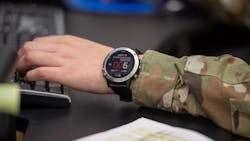DoD Fights Disease with Wearable Devices
Working with private industry and commercial-off-the-shelf (COTS) hardware, the U.S. Department of Defense’s (DoD’s) Defense Innovation Unit (DIU) has developed a wearable device that proved successful in detecting infectious viruses during the COVID-19 pandemic. The DIU is hoping to expand the use of wearable device technology for increased threat detection, including disease prevention.
Research was started in 2020 as part of the Rapid Assessment of Threat Exposure (RATE) program and has been successful in early detection of the COVID-19 virus. The DoD is expanding the RATE program to additional user groups in hopes of extending the capabilities of wearable devices to further disease and threat detection.
Early detection of the COVID-19 virus was achieved using a prototype wearable device that employs COTS hardware with a customized artificial-intelligence (AI) algorithm. The algorithm is based on reference data from confirmed cases of COVID-19 disease infection. By leveraging biometric data from commercial-grade wearable devices (see image above) and has been shown capable of detecting the design as much as 48 hours before symptoms appear.
Jeff Schneider, program manager for the RATE program, explained, “The DoD invests heavily in maintaining the readiness of its workforce to conduct essential missions. However, the risk of infectious disease, like COVID-19, has long been an unpredictable variable. With RATE, the DoD can use commercial wearables to noninvasively monitor a service member’s health and provide early alerts to potential infection before it spreads.”
The algorithm is device agnostic and can use biomarker data from any COTS wearable device.
About the Author
Jack Browne
Technical Contributor
Jack Browne, Technical Contributor, has worked in technical publishing for over 30 years. He managed the content and production of three technical journals while at the American Institute of Physics, including Medical Physics and the Journal of Vacuum Science & Technology. He has been a Publisher and Editor for Penton Media, started the firm’s Wireless Symposium & Exhibition trade show in 1993, and currently serves as Technical Contributor for that company's Microwaves & RF magazine. Browne, who holds a BS in Mathematics from City College of New York and BA degrees in English and Philosophy from Fordham University, is a member of the IEEE.
